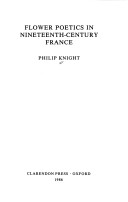Modern Language & Literary Monograph
1 total work
The title of Baudelaire's famed collection of poetry, Les Fleurs du Mal, suggests the importance of flower figures for one of the major French poets of the l9th-century. Yet, until now, critics have largely overlooked the significance of flower imagery for the poetics of Baudelaire, his Romantic predecessors, contemporaries, and Symbolist successors. In this study, Philip Knight examines the general trends in poetic flower imagery, discussing the influence of popular paraliterature's idealization of flowers, and finally arguing that flower figures became the one indispensable emblem of both continuity and change for the poets of the time.
